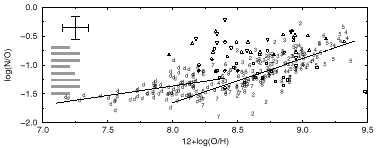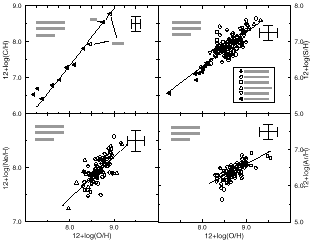


While metallicity patterns are apparently related closely to global galaxy properties, heavy element ratios such as N/O are expected to reflect characteristics of the IMF, stellar yield patterns, and star formation history. Papers on heavy element abundance ratios for the Milky Way included in this review are: Shaver et al. (1983; N/O, S/O, Ne/O, and Ar/O), Vílchez & Esteban (1996; N/O, S/O), Simpson et al. (1995; N/O, S/O, Ne/O), Maciel & Köppen (1994; Ne/O, S/O, Ar/O), and Fesen, Blair, & Kirshner (1985; N/O, S/O). Ratios for extragalactic H II regions are taken from papers by Thurston, Edmunds, & Henry (1996; N/O), Kobulnicky & Skillman (1996; N/O), Garnett (1989; S/O), and Garnett et al. (1995, 1997; C/O). Note that Simpson et al. used lines in the IR to infer their abundances. All papers considered H II regions with the exception of those by Fesen et al. and Maciel & Köppen which studied supernova remnants and planetary nebulae, respectively.
Figure 3 shows log(N/O) versus 12+log(O/H) for both the Milky Way and extragalactic objects. Milky Way data are shown with symbols whose shapes are interpreted in the legend of Fig. 4. Notice the segregation in the Milky Way data of the Simpson and Fesen points from the Shaver and Maciel points, perhaps due to the differences in the way these ratios were measured. T Type values are used as symbols for the Thurston et al. spirals, while ``d'' designates the Kobulnicky & Skillman dwarf galaxies. Parameters for least squares fits are indicated in the figure for the two extragalactic data sets only, where A = y - intercept, B = slope, and C = correlation coefficient. Because of the scatter in the Milky Way data, the following analysis applies only to the extragalactic N/O studies.

|
Figure 3. log(N/O) versus 12 + log(O/H) for Milky Way data (symbol shapes interpreted in Fig. 4) along with the extragalactic data of Thurston et al. (1996; integers indicating T type) and Kobulnicky & Skillman (1996; ``d''). Parameters (and uncertainties) for least squares fits are also shown for these two extragalactic data sets. |
The flatter N/O behavior seen at 12 + log(O/H) < 8.0 can be ascribed to the dominance of primary nitrogen production where CNO cycling is fed with carbon and oxygen derived directly from triple alpha processing within the same star. Thus, N/O is relatively independent of the star's metallicity. The steeper slope in N/O at higher metallcities is probably related to metallicity-sensitive secondary nitrogen production in which significant amounts of carbon and oxygen already present in the star enters into the CNO cycle. [See Vila-Costas & Edmunds (1993) and Thurston et al. (1996) for further discussion.] Finally, note the tendency for early type spirals (low integer values) to have systematically higher log(N/O) for the same 12 + log(O/H).
C/H, S/H, Ne/H, and Ar/H are plotted logarithmically against 12+log(O/H) in Fig. 4, where the legend connects symbol shape with data source, and the parameters (and uncertainties) defined as in Fig. 3 for the least squares linear fits are shown in each panel. Note that open and filled symbols designate Milky Way and extragalactic H II regions, respectively.

|
Figure 4. Logarithmic C/H, Ne/H, S/H, and Ar/H abundance ratios plotted against O/H for the samples indicated in the legend. Fit parameters (and uncertainties) are shown for each case. |
The top left panel of Figure 4 shows C/H values from Garnett et al. (1995; 1997) for extragalactic H II regions, along with results for galactic objects M 8 (Peimbert et al. 1993) and the Orion Nebula (Walter et al. 1992). The two results for Orion stem from the assumption of line-of-sight temperature fluctuations in the case of the higher value. The two points at low O/H are for I Zw 18. For purposes of the fit, the Orion collisional line abundance and the two points for I Zw 18 were omitted. A clear correlation exists between C and O, and with a slope significantly greater than unity, a metallicity-sensitive production mechanism for carbon is suggested.
Another strong correlation, assisted considerably by the extragalactic data, exists between S/H and O/H (top right panel). It is interesting to note the greater scatter for planetary nebula data than for H II region data. In all but the Simpson et al. work, S abundances were determined by combining S+ abundances with an ionization correction factor. However, the excitation level of planetary nebulae is generally higher than in H II regions, so planetaries should have proportionately less S+, and this method will be less accurate for them. The strong correlation shown in this plot, along with a slope close to unity, implies that S/O is generally constant. The average log(S/O) value is -1.76, close to the solar value of -1.66 (Grevesse & Noels 1993). This result agrees with Garnett (1989), although Díaz (1989) found a negative correlation between log(S/O) and 12+log(O/H). In addition to ionization correction factor uncertainties, sulfur abundance studies also suffer from the effects of severe telluric absorption on the IR [S III] 9069 Å and 9532 Å lines.
Ne/H and Ar/H appear to be correlated with O/H (bottom two panels), although the slopes are less than unity. Nevertheless, average ratios of log(Ne/O) = -0.70 and log(Ar/O) = -2.30, compare favorably with solar values of -0.80 and -2.27 (Grevesse & Noels 1993), respectively.
Tight correlations such as those between S, Ne, Ar, and O suggest that these elements are produced by primary nucleosynthesis in massive stars with yields that are invariant with metallicity. This issue was explored in the case of Ne and O in particular by Henry (1989), who found the interstellar Ne/O ratio to be constant in several different galaxies.